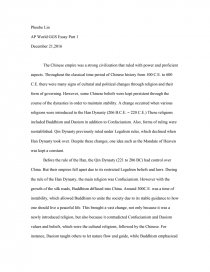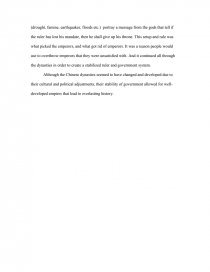Guns Germs and Steel
Essay by Phoebe Lin • November 21, 2017 • Essay • 710 Words (3 Pages) • 1,159 Views
Phoebe Lin
AP World GGS Essay Part 1
December 21,2016
The Chinese empire was a strong civilization that ruled with power and proficient aspects. Throughout the classical time period of Chinese history from 100 C.E. to 600 C.E. there were many signs of cultural and political changes through religion and their form of governing. However, some Chinese beliefs were kept persistent through the course of the dynasties in order to maintain stability. A change occurred when various religions were introduced to the Han Dynasty (206 B.C.E. – 220 C.E.) These religions included Buddhism and Daoism in addition to Confucianism. Also, forms of ruling were reestablished. Qin Dynasty previously ruled under Legalism rules, which declined when Han Dynasty took over. Despite these changes, one idea such as the Mandate of Heaven was kept a constant.
Before the rule of the Han, the Qin Dynasty (221 to 206 BC) had control over China. But their empires fell apart due to its restricted Legalism beliefs and laws. During the rule of the Han Dynasty, the main religion was Confucianism. However with the growth of the silk roads, Buddhism diffused into China. Around 300C.E. was a time of instability, which allowed Buddhism to unite the society due to its stable guidance to how one should live a peaceful life. This brought a vast change, not only because it was a newly introduced religion, but also because it contradicted Confucianism and Daoism values and beliefs, which were the cultural religions, followed by the Chinese. For instance, Daoism taught others to let nature flow and guide, while Buddhism emphasized the eight-fold path, and encouraged people to follow this path in order to reach nirvana. In addition, Confucianism philosophers began taking ideas from Buddhism and incorporating it into Confucianism to create what is called “Neo-Confucianism.” The shift from religion is one of the ways that a change was shown in the classic Chinese civilizations.
The fall of the Han dynasty also contributed to a major change factor of the time period. The uneven distribution of taxes lead to a large gap between the rich and the poor, where the poor payed a substantial amount greater than the rich. Therefore, when the Yellow Turban Rebellion occurred, the Han Dynasty falls into three separate states. The dynasty after the Han united China with a different approach to the organization of their empire. This dynasty was called the Sui dynasty, which took over in 581 C.E. Leaders learn from the mistakes of past rulers. Therefore, the first step in change was to make sure that there was a modified tax system to ensure the contentedness of the society and reduce rates of rebellion. That is exactly what Emperor Yang established. Then afterwards, he decides to use a centralized government to rule, and demands to build the Great Canal. This was a dramatic change from the Han Dynasty, where there was an immense division between upper and lower class, where the emperor had government officials who aided in his power, and where large building plans were not achieved. This greatly improves the performance of the Chinese empire, and reboots it from when it was subdivided.
...
...


